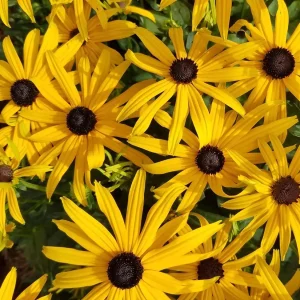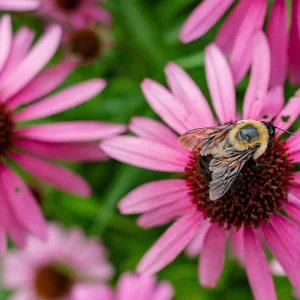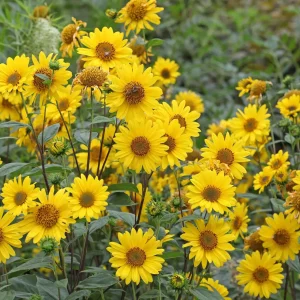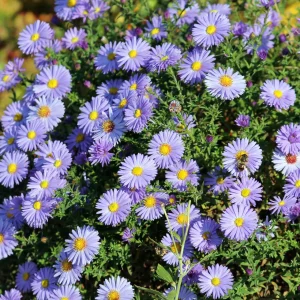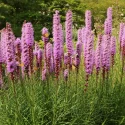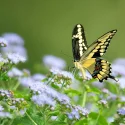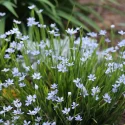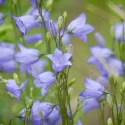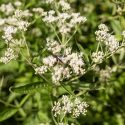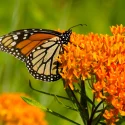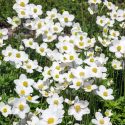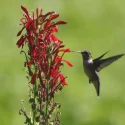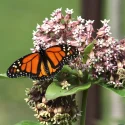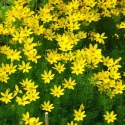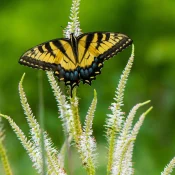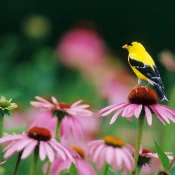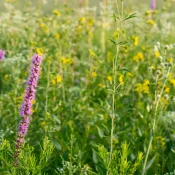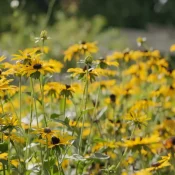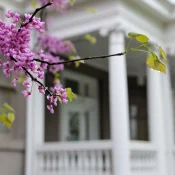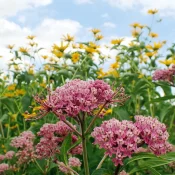Daisy vs. aster vs. chrysanthemum — what’s the difference?
If you’re new to native plants, you might wonder about the difference between familiar blooms like daisies, asters, and chrysanthemums. These popular flowers are everywhere—in nurseries, gardens, and even grocery stores, especially in fall.
While they may look similar, only asters include species native to North America. Let’s explore their differences, origins, and how to choose butterfly-friendly options for your garden.

These three plants have similarities, but only one deserves a celebrated spot in North American gardens.
Let’s start with what they have in common.
All three plants are in the same family
Daises, asters, and chrysanthemums all belong to the Asteraceae family, one of the largest plant families with over 20,000+ plant species.
If you’re about to scroll past this or close the tab, let me say—
Don’t be afraid or bored of Latin botanical names!
Most of the time, Latin names are referring to something basic and kindergarten-level, like a plant’s shape or color. (If you’re interested in learning a little more about Latin botanical names, check out our FAQ: Do I have to learn Latin?)
In the case of the Latin name Asteraceae—it refers to the flower shape.
- ‘Aster’ comes from the ancient Greek word for star
- All plant family names end in “aceae”—pronounced “ay-see-ee”
One look at a few plants in Asteraceae, and you quickly see what makes this star family special.
Meet the Asteraceae family
Some native star-family flowers include:
Members of Asteraceae share the same iconic shape we all learn to draw as kids: a round center with radiating petals. It’s one of the first ways we start recognizing and connecting with plants. Asters, daisies, and chrysanthemums all share this same shape.
Now that we’ve started to focus on the shared flower shape, we have a question for you:
Have you ever looked closely at the middle of an Asteraceae plant before? Because hiding in plain sight is a miniature universe…
All three plants have florets
Hidden within Asteraceae flowers is an incredible marvel: florets.

A tiny garden in one flower
Take a closer look at a New York Aster to see something amazing. Its center isn’t just one flower—it’s made up of hundreds of tiny flowers called ‘florets,’ each capable of producing a seed. From a distance, they all blend to look like one big bloom, but up close, it’s a tiny garden packed into a single flower head.
It’s amazing to realize that a single daisy, chrysanthemum, or aster flower is made up of dozens, sometimes hundreds, of tiny florets. If you’re like me, you might feel inspired to head into the garden, magnifying glass in hand, to get a closer look.
The floret’s double-edged sword
Here’s a surprising fact that sheds light on why some non-native daisies become invasive: each floret has the potential to produce a seed when pollinated. This means that one bloom in the Asteraceae family isn’t just one seed but dozens, even hundreds.
Let’s do some (scary) math.
Take the Oxeye daisy, native to Europe and Asia, as an example:
- An individual Oxeye daisy flower has 100–200 florets
- A single plant could yield thousands of seeds
- This prolific seed production (and rhizome-fragment spread) are why Oxeye daisies are considered invasive in some states
Now that we understand what connects asters, mums, and daisies, let’s dive into what makes each unique.
Global origins: Daisies, Chrysanthemums, and Asters each have unique native homes
One of the most apparent differences is that these three flowers come from different locations and have different bloom times.
Here are their native ranges and blooming seasons:
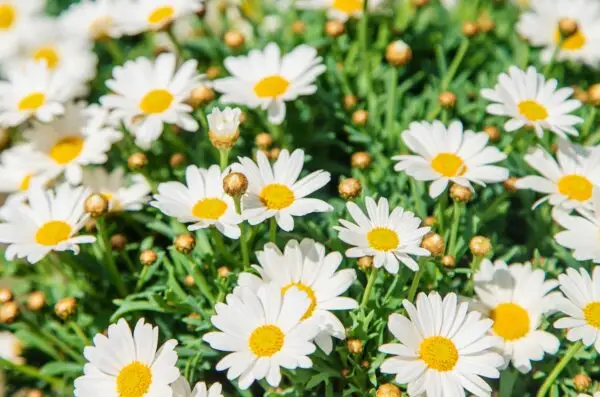
Daisies
- Shasta and Ox-eye Daisies are native to Europe and Asia
- Bloom in summer
- Perennials
- Leucanthemum genus (mostly)
- Can be invasive in some US states
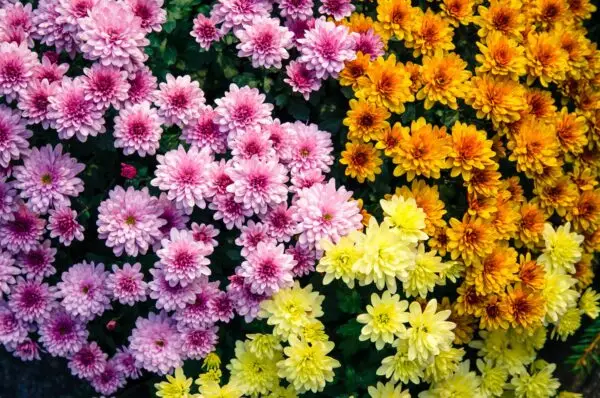
Chrysanthemums
- Chrysanthemums (often called ‘Mums’) are native to Asia and Europe
- Bloom in fall
- Many species cannot survive harsh winters
- Chrysanthemum genus
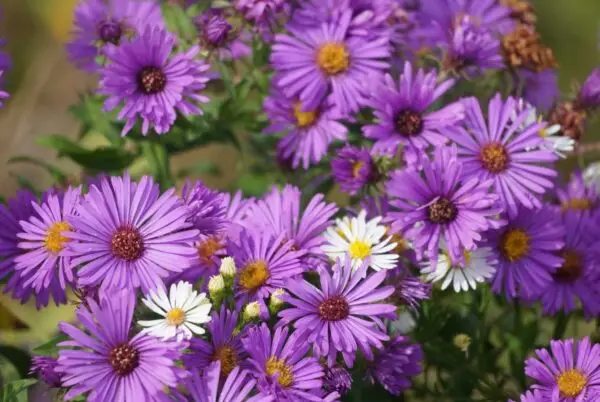
Asters
- There are 100+ asters native to North America
- Some are even host plants for butterflies
- Bloom late summer into fall
- Most are perennials (come back year after year)
- Symphyotrichum genus (mostly)
Surprised?
Perhaps you felt like I did—incredulous that daises are not native. They are part of American iconography! Like dandelions, tulips, or daffodils, daisies are non-native plants that have overtaken American landscaping. It’s time to change gardening trends and bring North American natives back.
Here are a few other notes on daisies if you’d like to dig a little deeper:
Shasta Daisies = Asian + European hybrid
Shasta daisies are actually hybrids of a few European and Asian daisies. A hybrid is a plant whose DNA comes from combining multiple plants.
Meet Shasta Daisy’s dad: Luther Burbank
Luther Burbank, a plant breeder, created over 800 plants through hybridization in his lifetime and created Shasta daisies in 1901. According to the Minnesota State Horticultural Society, “It took him 17 years, and he crossed the oxeye daisy with the English field daisy, the Portuguese field daisy, and the Japanese field daisy to create the Shasta daisy.”
Even though millions of Shasta daises grow in North American gardens, none of the daisy DNA used to make them is native to North America.
Ox-Eye Daisies are invasive in several states
Many states consider Ox-eye daisies invasive. Invasive plants can grow so rapidly and explode their populations so quickly that they crowd out native plant life.
The National Park Service explains the danger of Ox-eye daises (bolding is our own): “Ox-eye daisy is difficult to control or eradicate, since a new plant can regenerate from rhizome fragments. Each flower head can produce up to 200 seeds that spread by wind or animals and remain viable in the soil for several years.”
Yikes. Let’s stay away from this invasive and non-native flower.
What about sterile cultivars?
A few fellow plant enthusiasts have noted that there are sterile daisy cultivars available that do not produce viable seeds. (Here’s a quick cultivar overview.) However, as you can see from the National Park Service’s note above, even without seeds, non-native daisies can spread via rhizome fragments.
(Also, even sterile plants produce pollen, which can cross-pollinate with fertile plants to create more seeds/plants.) It’s safer to skip the daises for asters!
Otherwise, it’s time to start our love letter for native asters. They should be a star (Latin pun intended) in all North American gardens.
Only asters have options native to North America
Only asters have species that have grown in North America for thousands of years—making them a native plant.
Native plants are beneficial for our gardens for lots of reasons, including:
- Fuss-free beauty. It’s a good reminder that native plants plant themselves. Once established, they happily thrive in average weather with just rain.
- Resilience. Native plants have thousands of years of knowledge hidden within their DNA, which allows them to thrive in our climate, soil, and weather.
- Wildlife support. Native plants are the preferred home and food of our iconic wildlife. Speaking of wildlife…
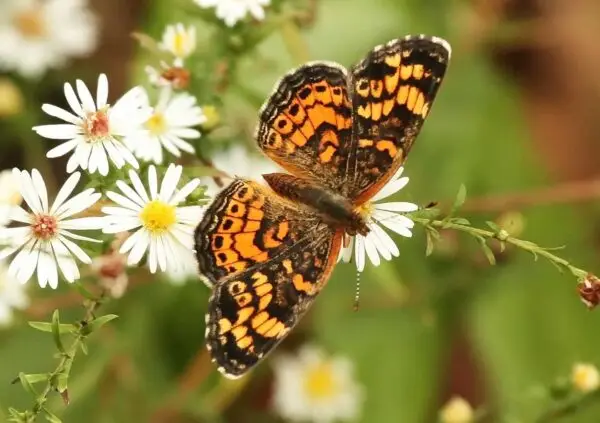
Native asters are the host plants for many butterflies
New England and New York Asters are host plants to Pearly Crescentspot, Crescentspot, and Silvery Crescentspot butterflies. Without their host plants, these butterflies would not exist.
What is a host plant?
A host plant is a specific plant that a bug, butterfly, or caterpillar eats, lives on, or lays its eggs on.
All these benefits and backstories make the choice clear: it’s time to put down the mums and daisies.
What to plant instead of daisies or mums
Swap daisies for coneflowers, black-eyed susans, or hummingbird mint
There are nine native coneflowers species, several black-eyed susan options, and half a dozen native species of the delightful hummingbird mint that thrive in the same full-sun environment favored by daisies. These native options offer long bloom times, lasting for 4+ weeks during the hottest days of summer.
And just like daisies, both coneflowers, (most) black-eyed susans, and hummingbird mint are perennials, meaning they will come back year after year.
For fall flowers, go with native asters
It’s a mystery why non-native mums dominate autumn landscaping when native asters offer stunning colors, thrive in North American climates, and return year after year. Let’s change the trend.
With around 120 native aster species across North America—blooming in shades of white, pink, and purple—there’s an aster for every garden. Start with three! Explore our Beginner’s Guide to Native Asters to find your perfect match.
What are good pairings for native asters?
Pair native asters with other native flowers that bloom during the spring and summer, so that your garden always offers food for pollinators. Ideas include:
Native plants for the spring
Native plants for the summer
Want to stick within the Asteraceae family?
As mentioned earlier, hundreds of native flowers include the same beautiful floret centers. Why not plant a native Asteraceae garden? Some favorites include:
And that sums up our guide to the differences between mums, asters, and daises! We hope this guide helped you understand their family tree alongside the benefits of planting native asters. Sadly, the iconic white-and-yellow daises and fall-time favorite chrysanthemums are not native to North America. But we have 100+ species of native aster to plant instead. Our Beginner’s Guide to Native Asters introduces a few species perfect for North American gardens. Happy planting!
Sources
- University of Nebraska-Lincoln. “Classification and Naming of Plants.” Department of Agricultural Leadership, Education and Communication. 2017. https://alec.unl.edu/documents/cde/2017/natural-resources/classification-and-naming-of-plants.pdf.
- Rolnik, A., & Olas, B. (2021). The Plants of the Asteraceae Family as Agents in the Protection of Human Health. International Journal of Molecular Sciences, 22(6). https://doi.org/10.3390/ijms22063009
- National Park Service. “Invasive Oxeye Daisy.” Lassen Volcanic National Park. Accessed July 21, 2024. https://www.nps.gov/lavo/learn/nature/invasive-oxeye-daisy.htm.
- Penn State Extension. “November Birth Flower: Chrysanthemum.” Penn State Extension. Accessed July 21, 2024. https://extension.psu.edu/programs/master-gardener/counties/luzerne/news/november-birth-flower-chrysanthemum.
- Minnesota State Horticultural Society. “Plant Profile: Shasta Daisy.” Northern Gardener. June 18, 2018. https://northerngardener.org/plant-profile-shasta-daisy/.
- Wikipedia. “Chrysanthemum.” Wikipedia, The Free Encyclopedia. Last modified July 14, 2024. https://en.wikipedia.org/wiki/Chrysanthemum.
- Encyclopædia Britannica. “Asteraceae.” Encyclopædia Britannica. Accessed July 21, 2024. https://www.britannica.com/plant/Asteraceae.
- FTD. “Types of Daisies.” FTD Blog. Accessed July 21, 2024. https://www.ftd.com/blog/types-of-daisies.
- Montana State University Extension. “Oxeye Daisy.” Montana State University Extension. Accessed July 21, 2024. (PDF).
